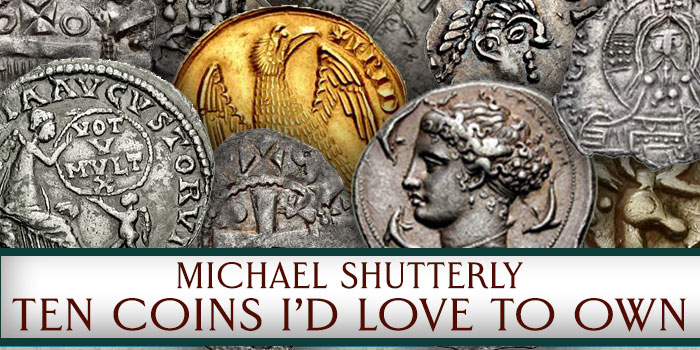
By Michael T. Shutterly for CoinWeek …..
I enjoy coins for their artistry and for the history behind them. Because there are so many coins with an interesting history behind them, and because there are so many coins that demonstrate great artistry, I can think of far more than just Ten Coins I’d Love to Own. I narrowed my list down to those I would MOST love to have, and that I am MOST likely to be able to obtain, someday, without having to sell more than one or two vital organs. Here is my list, in reverse chronological order.
Eighth Stavraton of Constantine XI
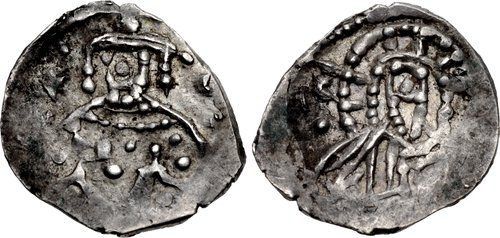
There are only 92 coins known from the reign of Constantine XI, the last Roman (or Byzantine to some) emperor. Fifty of Constantine’s coins are eighth stavrata, all of which come from a single hoard that was buried just before or just after Constantinople fell to the Turks on May 29, 1453. Constantine struck the eighth stavrata to pay soldiers and workmen during the final siege of Constantinople; he obtained the silver for the coins by melting chalices and other treasures he “borrowed” from the city’s churches.
The aesthetic qualities of the coins are dismal, but as memorials to the end of the Roman Empire and to the fall of what had been the greatest city in the world, their historical importance is unmatched. When the coins appear on the market they sell at prices that range from about $3,000 to $30,000 USD, with the price largely dependent on the length and legibility of the inscriptions.
Augustalis of Frederick II

The Holy Roman Emperor Frederick II was known in his own time as Stupor Mundi (“The Wonder of the World”), a Renaissance prince before there was a Renaissance. The most enlightened and probably best-educated ruler of Medieval Europe, he was an active patron of the arts and sciences of his time; Frederick himself wrote an important and authoritative treatise on falconry. He is often regarded as the first truly modern ruler.
One of Frederick’s many achievements was to launch a gold coinage that compared favorably with the gold coins of ancient Rome. The sensitive portrait on his augustalis stands high above the flat, lifeless renderings that appear on the coins of his contemporaries. The augustales usually sell for prices in the $10,000 to $20,000 range, although a few nice specimens have sold for as little as $5,000, and others for more than $60,000.
Denier of Provins et Sens

Provins was the capital city of the county of Champagne and was one of the most important cities in Medieval France. It was a major center of the wool trade and it hosted one of the largest Champagne Fairs, the greatest trade shows of the Middle Ages.
The reverse of this denier displays a wool comb in the center field. The French word for “field” is champs and the word for “comb” is peigne: the pronunciation of “champs peigne” is almost identical to the pronunciation of “Champagne” – the name of the Medieval French county of which Provins was the capital. This is one of the cleverest punning references to be found on any coin, anywhere, and is well worth the $100 or so that the coin might cost. The major obstacle to obtaining one of these deniers is that it is very difficult to find one with a clear design.
Srebrennik of St. Vladimir

Vladimir I, Grand Prince of Kievan Rus’, is credited with converting the Rus’ to Orthodox Christianity. According to one legend, he rejected Islam because of its prohibition of alcohol, which Vladimir called “the joy of the Rus’.” He rejected Judaism, believing that the suffering of the Jews indicated that God had abandoned them. He rejected Latin Christianity when his ambassadors reported that Western churches were dark and gloomy, with no joy. He decided upon Orthodox Christianity based upon the reports of his agents in Constantinople, who attended services at Hagia Sophia and told him that “We no longer knew whether we were in heaven or on earth, nor such beauty, and we know not how to tell of it.”
Vladimir’s efforts earned him sainthood in the Orthodox Church, which managed to overlook Vladimir’s murder of his older brother and seizure of the Kievan crown, as well as the murder of the parents of the second of his five wives, and his marriage to her against her will.
Vladimir was the first Grand Prince of the Rus’ to mint coins in his own name, and his very first coins celebrated his conversion to Orthodox (Byzantine) Christianity. The coins were not popular at the time, containing very low-grade silver in a world of high-quality Byzantine and Arabic coins of the same metal. Until recently most of the known specimens of Vladimir’s coins came from one or the other of two 19th-century hoards, and most of those coins were held in Russian museums.
More specimens have become available since the fall of the Soviet Union, but the coins are still not common. Most of the coins are damaged in some way with splits, cracks, and chips broken off. “Better” (a relative term) specimens usually sell for prices in the $3,000 to $10,000 range. Small fragments of coins often appear in the market and can be had for prices under $1,000.
London Penny of Alfred the Great
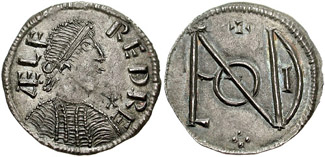
Alfred became King of Wessex in 871, the fourth of four brothers to reign in succession. He is in many respects the founder of what came to be known as England. Among his other achievements, Alfred reorganized the military and civil administration of his kingdom, reformed the coinage, promoted the use of “English” rather than Latin in education, issued a new legal code, and he turned back the previously-unstoppable tide of the Danish invaders. He is the only English sovereign known as “the Great”.
Alfred took control of London from the Danes in the 880s. He redeveloped London as a major political and economic center, which led to the city eventually becoming the capital and most important city of England and later the United Kingdom.
He “sealed the deal” by minting coins in London with his name and portrait. These coins are highly prized by collectors, as well they should be: nice specimens can sometimes be found for prices in the mid-to-high four figures, but really nice coins typically run more than $20,000 (sometimes, much more).
Tremissis of St. Eligius
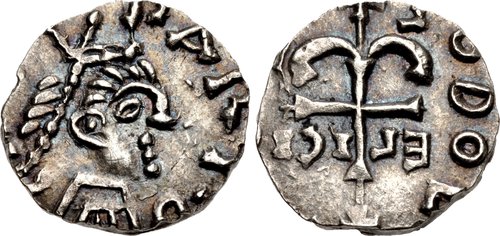
Eligius was a goldsmith and moneyer who also served as the chief advisor to Merovingian kings. He later became Bishop of Noyon-Tournai. He was noted for his piety, for his missionary work, for founding monasteries, and for exceptional acts of charity and mercy. He regularly purchased slaves in the slave markets and then immediately freed them, and he arranged for the decent burial of executed criminals.
Eligius is also the only moneyer who has been canonized a saint, and he is the patron saint of coin collectors. What coin collector would not love to own a coin minted by an honest-to-God saint, with the saint’s name on the coins themselves? When Eligius’ tremisses come onto the market they generally command prices in the mid-four-figure range.
London Mint Solidus of Magnus Maximus

Magnus Maximus (whose name literally means “Great the Greatest”) was serving as the Roman military commander in Britain when his troops proclaimed him Emperor in July 383. He was very popular in his own time – particularly in Britain, where he was later remembered very favorably in Welsh legend under the name “Macsen Wledig”.
Early in his reign, Maximus reopened the Roman mint in London, which had closed nearly 60 years earlier. The Roman name of the city had changed to Augusta in 368, as a result of which the coins Maximus struck there are mintmarked AVG. The gold solidi from this mint generally sell for low five-figure prices, while the silver siliquae (which appear infrequently on the market) generally sell for low-to-mid four-figure prices.
Maximus was the last Roman emperor to mint coins in Britain. More than 200 years would pass before coins would again be minted on the island, and these would be minted by the Anglo-Saxons who occupied Britain after Maximus removed most of the Roman troops who had been stationed there.
Roman Republican AES Grave As
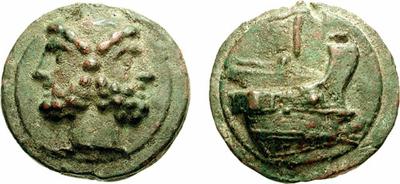
The earliest Roman “money” consisted of cast lumps of bronze of variable sizes. These evolved over time until, beginning around 280 BCE, the Romans began casting bronze coins based upon an as of 324 grams. Although the weight of the coin declined over time, the as formed the basis of the Roman coinage system for generations. The name of Rome’s signature coin, the silver denarius, itself comes from a word meaning “containing 10” and refers to the denarius’ original value of 10 asses.
The Romans began using a ship’s prow as a reverse design on the as following the First Punic War (264-241 BCE), during which they created their first navy by reverse-engineering a shipwrecked Carthaginian quinquereme. The Romans also commemorated their victory in the First Punic War by mounting the prows of captured Carthaginian ships in the Roman Forum; a ship’s prow was often referred to as a “beak” (rostrum in Latin) and the use of prows around the speaker’s platform in the Forum led to the platform itself becoming known as the Rostrum, a term we continue to use. Ironically, the military disasters of the early part of the Second Punic War (218-201 BCE) led to the destruction of the Roman economy, and the cast bronze as was discarded in about 211 BCE as part of the denarius reform.
Tetradrachm of Kimon
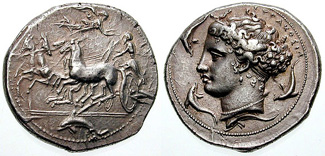
Kimon was the greatest die engraver who ever lived. Working in ancient Syracuse on the island of Sicily from about 415 BCE to about 390 BCE, he created magnificent dies for striking coins in denominations great and small, in gold, silver, and bronze. His designs tended to favor realistic rather than idealized portrayals (to the extent that a portrait of a goddess or water nymph can ever be “realistic”), and he emphasized precise details in his depictions.
Kimon’s best-known works are the six signed and seven unsigned (known) dies he created for the dekadrachms struck circa 405-390 BCE. Unfortunately, with very few exceptions, those coins typically bring six-figure prices, so they are more “fantasy” than “dream” coins. On the other hand, every die Kimon created was a masterpiece, and there are coins attributed to him that can be found for more affordable prices. The tetradrachm shown here was struck with dies similar to those used for Kimon’s dekadrachms but it sold at auction in January 2002 for “only” $18,000. A comparable specimen struck from the same dies sold in January 2021 for $16,000.
Tetartemorion (1/48 Stater) of Phanes

Phanes (whoever or whatever Phanes might have been) struck the first coins to bear inscriptions. The approximately seven known staters bear inscriptions reading something similar to ΦΑΝΕΟΣ ΕΜΙ ΣΗΜΑ (usually translated as “I am the Badge of Phanes” but sometimes as “I am the Sign of Light”), while the approximately 17 known trites (1/3 staters) are inscribed with the name ΦΑΝΕΟΣ (“Of Phanes”). Phanes (whoever or whatever Phanes might have been) also struck smaller coins – the hekte (1/6 stater), the hemihekte (1/12 stater), the myshemihekte (1/24 stater), the tetartemorion (1/48 stater), and the ninety-sixth stater – that are in the same style as the staters and trites but which are too small to include inscriptions.
The coins of Phanes have tremendous historical importance as the earliest known coins that identify the authority responsible for issuing them. Unfortunately, the coins with inscriptions are quite expensive – the staters typically bring six-figure prices, while the trites usually command mid-five-figure prices. The uninscribed Phanes denominations – most of which are also quite rare – share a place in history with the staters and trites but are much more affordable. The myshemihektes can generally be obtained for less than $1,000, and the other denominations are usually obtainable for low-four-figure prices. I would love to own the tetartemorion shown here… in fact, at one time I DID own the very tetartemorion shown here until I lost it while trying to photograph it for an exhibit (the image shown here was prepared by the auctioneer who sold it to me).
Summary
These are the 10 coins at the top of my wish list. Each reflects one aspect or another of my somewhat eclectic interests in art, and each provides a window on our past. I hope you enjoyed reading about these coins as much as I enjoyed thinking and writing about them.
Image of Srebrennik of St. Vladimir courtesy and copyright of Heritage Auctions (HA). All other coin images courtesy and copyright of Classical Numismatic Group, LLC (CNG).
* * *
About the Author
Michael T. Shutterly is a recovering lawyer who survived six years as a trial lawyer and 30 years working in the financial services industry. He is now an amateur historian who specializes in the study of ancient Rome and the Middle Ages, with a special interest in the art and history of the coins of those periods. He has published over 50 articles on ancient and medieval coins in various publications and has received numerous awards for his articles and presentations on different aspects of the history of the ancient and Medieval world. He is a member of the ANA, the ANS, the Association of Dedicated Byzantine Collectors, and numerous other regional, state, and specialty coin clubs.





Me ha parecido una colección importante, seria y extraordinaria por su pertenencia miles de años atrás.
Digamos que este Sr. NOS MUESTRA LA HISTORIA DE UNA PARTE GRANDE DEL MUNDO NUMISMSTICO PROVENIENTE DE DIVERSOS PAISES QUE FUERON FORMANDO LA CUNA DE LA MONEDA.
Thanks again for another superb article as I skip merrily through your back catalog! My condolences on the loss of your tetartemorion. Seeing as how it’s likely worth a fair portion of my own modest collection, that would definitely keep me up some nights.